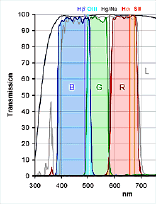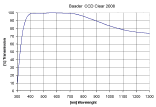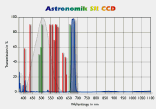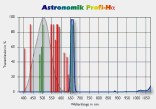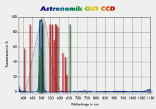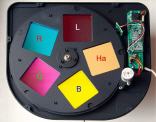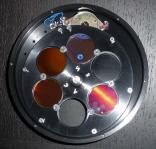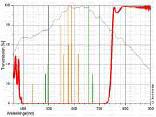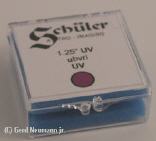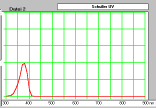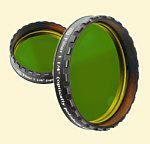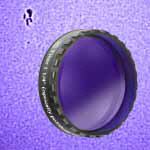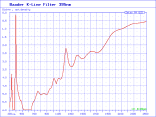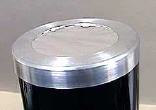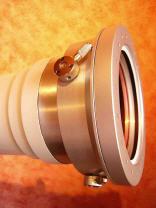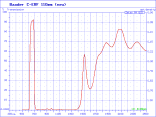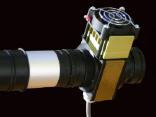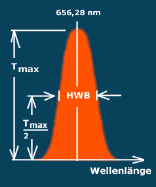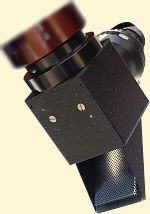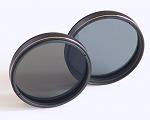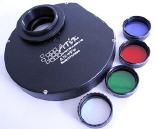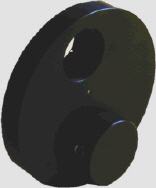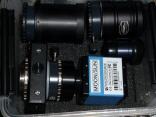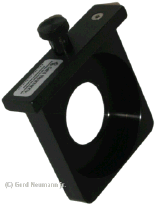Filters and Filterwheels
L-R-G-B-C filterset Deepsky/ Intes-MN61
For the color imaging of deepsky objects the L-R-G-B-C (1.25'') filterset
from Baader-Planetarium Germany is used in combination with the ST10-XME SBIG CCD camera.
In order to place these filters in the very small and compact 8 position FR-03 filterwheel of Gerd Neumann, the original filterhousing of the baader filters had to be replaced by the housing of Astronomik filters! Anyhow the baader glas plates fitted perfectly in the Astronomik ones. A small filter opening tool (looks like a stamp and provided by Gerd Neumann) facilitated this replacement.
Pos 1 • L= light filter (UV/IR cut) ... Baader
Pos 2 • R= red filter ... Baader
Pos 3 • G= green filter ... Baader
Pos 4 • B= blue filter ... Baader
Pos 8 • C= clear (UV/IR pass) ... Baader
Photos are taken individually through each filter and combined finally to a color picture. For instance the software Photoshop supports this approach. The color information is coming from the R-G-B filterset and the details in the picture may be improved by the addition of a L-filter picture, which blocks the IR and UV part of light. Because the UV/IR wavelenghts focus behind the projection lenses (with normal glassorts) in a different focalplane on the CCD Chip, it is better to block them. Unfortunately the CCD chips are normally highly sensitive to the IR wavelenght.
The filtered wavelenghts exclude the mercury line from light polluted areas. All three wavelenghts R-G-B are kept in a 1:1:1 ratio and with highest efficiancy.
The filtercurves of the noval Baader L-R-G-B-C set.
The filtercurve of the Clear Filter (Baader)
SII-Halpha-OIII filterset Deepsky/ Intes MN61
The ST10-XME holds additionally in the FR-03 filterhousing a SII-Halpha-OIII filterset from Astronomik, germany. It is required to generate special colorphotos from certain objects at the deepsky.
Pos 5 • R/SII = sulfur/'red' filter ... Astronomik
Pos 6 • G/Halpha = hydrogen/'green' filter ... Astronomik
Pos 7 • B/OIII = oxigen/'blue' filter ... Astronomik
Many people are now using H-alpha, SII, and OIII filters for tri-color CCD imaging, rather than the traditional RGB filters. Green represents ionized hydrogen from an H-alpha filter. Red represents ionized sulfur from an SII filter. Blue represents ionized oxygen from an OIII filter. Thus, narrowband filters can provide additional detail about the structure of emission nebula.
The filtercurve of SII filter.
The filtercurve of Halpha filter.
The filtercurve of OIII filter.
L-R-G-B-Ha 68mm filterset Deepsky/ SBIG STX and Keller-ASA-Cassegrain
The filters have a 68 mm opening which caused quite some vignetting in the cassegrain setup. For the color imaging of deepsky objects a larger diameter L-R-G-B-Ha of 68mm is required in order to prevent the vignetting during autoguiding with the internal guider chip. A frameless filterset
from Baader-Planetarium Germany is used in combination with the STX-16803 SBIG CCD camera. The filterplates are placed in the slots of the STX filterwheel.
Pos 1 • L= light filter (UV/IR cut)
Pos 2 • R= red filter or SII=sulfur/'red' filter ... Hubbel Palette
Pos 3 • G= green filter
Pos 4 • B= blue filter or OIII=oxigen/'blue' filter ... Hubbel Palette
Pos 5 • Ha=H-alpha filter Ha=hydrogen/'green' filter ... Hubbel Palette
The three narrow band filters SII/Ha/OIII may assorted to the R/G/B channels in the imageprocessing program as required.
L-R-G-B-Ha-OIII filterset Deepsky/ Keller-ASA-Cassegrain
The 1.25'' filters have a 27mm opening which caused quite some vignetting in the cassegrain setup. For the color imaging of deepsky objects a larger diameter L-R-G-B-Ha-OIII of 36mm is required in order to prevent the vignetting. A frameless filterset
from Baader-Planetarium Germany is used in combination with the ST10-XME SBIG CCD camera. The filterplates are placed in the 38mm slots of the F03 filterwheel.
Pos 1 • L= light filter (UV/IR cut) ... Baader
Pos 2 • R= red filter ... Baader
Pos 3 • G= green filter ... Baader
Pos 4 • B= blue filter or SII=sulfur/'red' filter... Baader
Pos 5 • Halpha = hydrogen/'green' filter ... Baader
Pos 6 • OIII = oxigen/'blue' filter ... Baader
L-R-G-B filterset Planets
For the color imaging of planets another L-R-G-B filterset (from Baader Planetarium D ) is placed in a motorized ATIK-filterwheel and linked to the black and white DMK41-CCD cameras in my projection setup.
• L= light filter (UV/IR cut)
• R= red filter
• G= green filter
• B= blue filter
Photos are taken individually through each filter and combined finally to a color picture. For instance the software Photoshop supports this approach. The color information is coming from the R-G-B filterset and the details in the picture may be improved by the addition of a L-filter picture, which blocks the IR and UV part of light. Because the UV/IR wavelenghts focus behind the projection lenses (with normal glassorts) in a different focalplane on the CCD Chip, it is better to block them. Unfortunately the CCD chips are normally highly sensitive to the IR wavelenght.
Another trick to generate sharp pictures is to use the Baader FFC as a projection eyepiece. It contains a Ca-Fluorid lens and combined with its generally high optical quality, the IR wavelenghts are focused almost in the same focalplane, as the visible part of spectrum.
For filtercurves see above...
IR pass - Schüler UV pass - K line Calcium- Solar Continuum filters
For planets and sun projection photography.
IR-pass filter 742
The filtercurve of the IR-pass filter (742) Astronomik
Ideal filters for the reception of the moon and planets, notably Mars, with telescopes from 6" (150mm) aperture. The planet IR Pro 742 only allows infrared light with wavelengths of more than 742 nm to pass. In this wavelength range the effects of seeing are significantly lower than in the visible spectrum of the human eye. This allows much sharper images than are usually obtained from your device and location. Another advantage is that the sky background of advanced dawn is dark and so the filter even allows photography of the planets and the moon at daylight.
The Schüler UV pass filter distributed by Gerd Neumann, germany .
The filtercurve of the Schülerfilter
The Solar Continuum filter
It is implemented into the Baader Herschel Wedge Solar Prism 2" and also used in the FFC projection unit for the white light photography with DMK video cameras.
In both cases, the filter narrows the range of the spectra to the 540nm wavelenght, which results in a higher conrast and slower movement of the picture.
The filtercurve of the Solar Continuum filter.
The Baader K-Line-filter
It selects the wavelenghts of 395nm, which are emitted from the element Calcium on the sun. The filter is a stacked product made of two different glasses. This filter is used behind the MN-61 telescope, with the AstroSolar safety film (CCD photographic version D=3.8), in the university optics eyepiece projection unit, together with DMK video cameras. The FFC projection eyepiece is here less suitable, because the Calciumfluorid lens may block the UV-light of interest. The K-Line-filter is only made for CCD imaging.
Because the wavelenght is close to hard UV light, don't use it visually!
You won't see anything at all, because the human eyes are not sensible to this wavelenghts!
You may most likely damage the light receptors in your eyes!
The filtercurve of the Baader K-Line (Ca) filter (by courtesy of Peter Höbel, germany)
Solar filterfoil
The MN61 solarfilter is manufactured with the AstroSolar safety film (CCD photographic version D=3.8) from Baader, germany. The aluminium ring was made for the MN61 Intes by Telescope Service Ransburg, germany . Using the safety film most of the sunlight is rejected before it enters the Maksutow Newton telescope and finally the CCD chip. This filter is always fixed with tape to the black dewcap, before the telescope is pointed to the sun, in order to prevent an occasional drop of it! For visuell observations, an even more dense version of AstroSolar safety film (visuell version D=5.0) is available and absolutely required to protect your eyes!
Danger:
• Don't let the sun enter directly into your Newton telescope, without any filtering!
• Never try to reduce the energy only at the end of the optical pathway!
• The secondary mirror, the eyepiece or your eyes may become destroyed!
• Also never use the almost black eyepiece filter, which are sometimes distributed, they may most likely crack and you will most likely become blind in even parts of a second!
• Be careful, there are experiments in the world you do only one time, please asked an expert before you look to the sun!
The C-ERF 'Cold-Energy Rejection Filter' (Baader, germany)
It protects the refractor from the IR wavelenghts and thereby from heating through the sun. In order to adjust stepless the opening for the corresponding telezentric lenses TZ2, TZ4 the filter is combined with an iris aperture (Baader germany).
The filtercurve of the C-ERF
The SO-1 (19mm) H-alpha Filter (0.2A)
It is made by Solar Spectrum and distributed by Baader, germany. It is mounted in a housing with a temperature controller, enabling the control of temperature and thereby the wavelenght around 656.3nm. The optimum of my verson is around 41 C and heating shifts the wavelenght to longer wavelenghts and cooling to shorter ones. Possible movements of flares in the direction to the observer can be followed by the active changes of the wavelenght, taken the doppler effect into account.
The definition of the half wide maximum of the filter (here 0.2A).
The Herschel Wedge Solar Prism (Baader, germany) reduces the white light by reflecting only a minor part upwards to the eyepieceholder. The rest of the high energy is guided through a prism downwards, out of the housing. It works only with refractors and not with any other design of telescope!
Herschel Wedge Solar Prism offers the finest white-light solar views obtainable. The Herschel wedge prism provides safe full-aperture solar views without any image degradation. Views are noticeably superior in resolution and contrast to even the very finest and most expensive glass objective solar filters and films. The amount of Sunspot detail and surface granulation will surprise even the most experienced solar observer. The solar disc is set against a jet-black sky, like observing the full moon at night! A further benefit is the true unfiltered nature of the spectrum passed by the filter. Unlike all objective solar filters, the Baader Herschel Wedge does not selectively filter any of the visual wavelengths. This provides a true white-light view, and permits the use of additional eyepiece filters to selectively study any bands desired, without the compounding effects of a pre-filter.
I use normally this prism in combination with the Zeiss Binoviewer and the Leica Plan 25mm eyepieces...
The grey filters
They are used to adjust the white light in the Herschel Safety Wedge Solar Prism to the visuell or CCD setup.
The two filterwheels of ATIK are motorized and contains various filters. For details see Projection setups
The filterwheel FR-3 (Gerd Neumann, germany) has in the setup for the 6 Zoll newton (Maksutow Intes) 8 positions and is fixed to the SBIG ST10-XME. It contains the following 7 filters L-R-G-B-SII-OIII-Halpha (s.o.) and one empty position. In order to prevent the vignetting in a 16 Zoll Cassegrain, 36mm frameless filters are used in a 6 position setup. Both setups are triggered by the MaximDL4 software or by a manuell switchbox.
For the moon and the sun a filterdraw (Gerd Neumann) is combined with a DMK41 camera.
The inserts of the filterdraw may harbor 1.25 or 2 Zoll filters.


